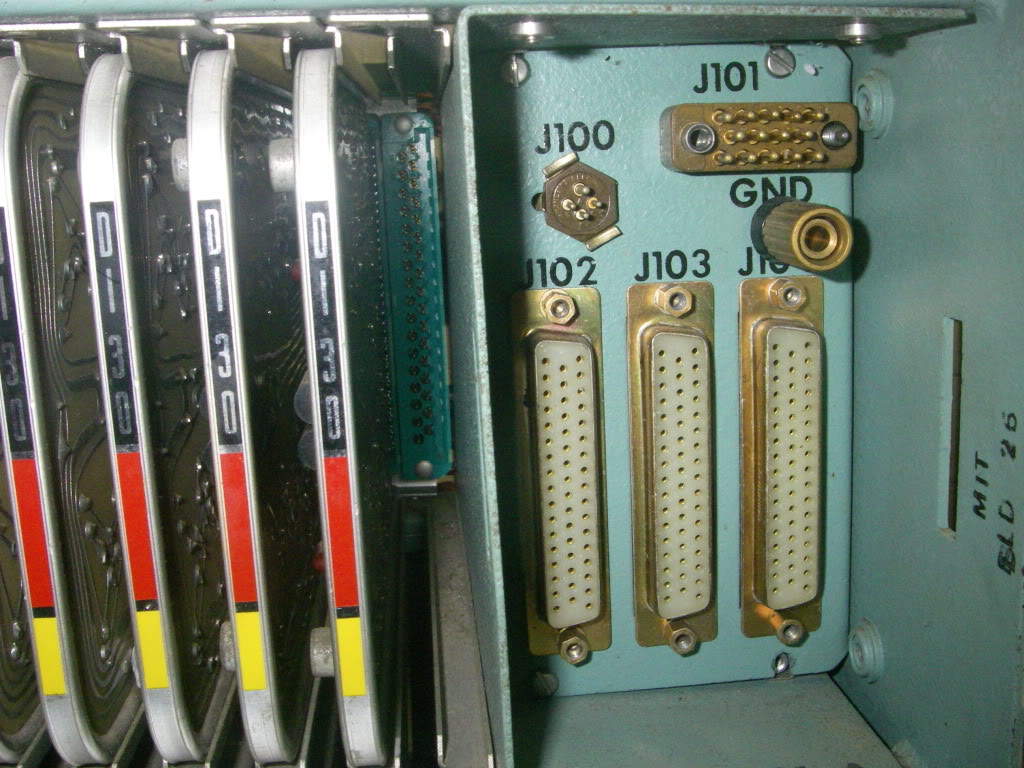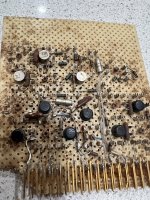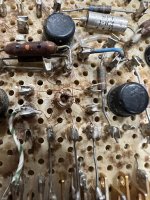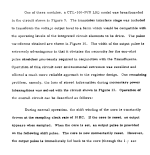Upcoming Events:
- VCF South West - June 14 - 16, Davidson-Gundy Alumni Center at University of Texas at Dallas
- VCF West - Aug 2 - 3, Computer History Museum, Mountain View, CA
- VCF Midwest - Sept 7 - 8 2024, Schaumburg, IL
- VCF SoCal - Mid February 2025, Location TBD, Southern CA
- VCF East - April 2025, Infoage Museum, Wall NJ
-
Please review our updated Terms and Rules here
You are using an out of date browser. It may not display this or other websites correctly.
You should upgrade or use an alternative browser.
You should upgrade or use an alternative browser.
Unusual Transistor Computer card
- Thread starter tgarnold
- Start date
Chuck(G)
25k Member
Agreed that it appears to be a DIY lashup. The little push-in-terminals "flea clips" that are attached to the homebrew pulse transformers and other components were very common in the perfboard-and-wire setups in the 60s and 70s. Keystone still makes them: https://www.keyelco.com/product.cfm/Terminals-Push-In/1500/product_id/2572
daver2
10k Member
That actually looks like a really interesting card.
It is likely to be some form of magnetic logic board.
I am intrigued...
Dave
It is likely to be some form of magnetic logic board.
I am intrigued...
Dave
So, to add to the intrigue, this is likely a card used by the JPL (Jet Propulsion Lab) in Pasadena, California (predecessor of NASA and now part of NASA). I have a number of oddities that I am trying to wrap my head around. I'll probably post more boards and cordwood units. I think many were purpose built for satellites and missile systems. I have a bunch of electronics from JPL surplus bought in the early 1970s (so prior to that). I'll post a pic of the back as well. It has a single transistor.
VERAULT
Veteran Member
magnetic logic. Is that what those multi point self wound coils are? Intriguing.
daver2
10k Member
Yep.
There are some interesting (old) US DOD documents on the Internet related to magnetic logic.
Dave
There are some interesting (old) US DOD documents on the Internet related to magnetic logic.
Dave
Chuck(G)
25k Member
There are actually a few types of magnetic logic. Two production examples come to mind--and very different from each other. The first is the Univac Solid State mainframes, from a time when transistors were not considered to be reliable devices. See: http://bitsavers.org/pdf/univac/uss/ for a bunch of documentation. The interesting thing about these is that they use majority logic.
Another production device was Eichi Goto's parametron used in NEC's NEAC 1101 system. https://museum.ipsj.or.jp/en/computer/dawn/0017.html
Multi-aperture "hard" cores were also used.
Another more pedestrian use was the magnetic amplifier: https://www.nutsvolts.com/magazine/article/the_magnetic_amplifier Used in very hostile environments, enables a small current or currents to control a large one.
Another production device was Eichi Goto's parametron used in NEC's NEAC 1101 system. https://museum.ipsj.or.jp/en/computer/dawn/0017.html
Multi-aperture "hard" cores were also used.
Another more pedestrian use was the magnetic amplifier: https://www.nutsvolts.com/magazine/article/the_magnetic_amplifier Used in very hostile environments, enables a small current or currents to control a large one.
daver2
10k Member
Chuck(G)
25k Member
Yes, see the documentation cited on the USS. But your article misses an important feature--that of the majority gate. So, a 4 input gate can be configured as "any 2 or more" or "at least 3 with one inhibit"... One interesting aspect of the USS, is that it preserves its state when power is removed.
jlang
Experienced Member
Nice rabbit hole you sent me down. The USS is both amazing and primitive at the same time.There are actually a few types of magnetic logic. Two production examples come to mind--and very different from each other. The first is the Univac Solid State mainframes, from a time when transistors were not considered to be reliable devices. See: http://bitsavers.org/pdf/univac/uss/ for a bunch of documentation. The interesting thing about these is that they use majority logic.
Another production device was Eichi Goto's parametron used in NEC's NEAC 1101 system. https://museum.ipsj.or.jp/en/computer/dawn/0017.html
Multi-aperture "hard" cores were also used.
Another more pedestrian use was the magnetic amplifier: https://www.nutsvolts.com/magazine/article/the_magnetic_amplifier Used in very hostile environments, enables a small current or currents to control a large one.
And it all fits on just 1000 circuit boards.
Chuck(G)
25k Member
...But they're little circuit cards! (like the CDC 6600 cordwood modules).
Not to mention the neat tube-based clock driver! Some fellows in the Netherlands got one working in the 1970s. http://www.ussc90.nl/
Not to mention the neat tube-based clock driver! Some fellows in the Netherlands got one working in the 1970s. http://www.ussc90.nl/
pbirkel@gmail.com
Veteran Member
Neat reference Chuck. Page describing "AC" logic design: http://www.ussc90.nl/circ.htm
1700(!) boards mentioned there.
1700(!) boards mentioned there.
Thanks to all for the great information. I have been researching early ICs (DTL, RTL and TTL) in the JPL data archives. One of the documents I found is called "Circuits and circuit testing for spaceborne redundant digital systems Special technical report no. 3" It covers research in comparing magnetic logic and semiconductor logic. I have several early 1960s ICs from Fairchild, TI, etc. and I didn't realize this is likely one of the magnetic logic devices. Here is a small excerpt with a diagram.


Chuck(G)
25k Member
For those used to today's semiconductor logic, it's important to note that there are no static logic levels--it's all "pulse" or nothing. Each core represents a delay element requiring a clock signal to change state. Essentially, the clock supplies the energy to the system.
One last follow-up on this. After interpreting the company codes in the JPL document, it looks like the breadboard is a magnetic logic board using RCA transfluxors for a 3C Computer Control Company DDP-24 computer. Thanks to everyone for the invaluable input!
DDP-24 https://www.p3oriontopsecret.com/3c-computer-control-company-ddp-24-card-rack.html
DDP-24 https://www.p3oriontopsecret.com/3c-computer-control-company-ddp-24-card-rack.html
Chuck(G)
25k Member
Interesting that these cards appear to plug into standard D-sub connectors.
pbirkel@gmail.com
Veteran Member
Those are for external cables, right? The cards have those elevated male spade-like L-shaped tabs that presumably fit a matching female slot array.Interesting that these cards appear to plug into standard D-sub connectors.

Looks like they plug into this. Copied from DDP-24 https://www.p3oriontopsecret.com/3c-computer-control-company-ddp-24-card-rack.html
Chuck(G)
25k Member
Finally got the site loaded. Those card sockets makes sense; the D-sub didn't.
So this was in those sub-chasers out of Moffett in the 70s and 80s that rattled my windows when I lived in Sunnyvale? Huh...
So this was in those sub-chasers out of Moffett in the 70s and 80s that rattled my windows when I lived in Sunnyvale? Huh...
Last edited:




